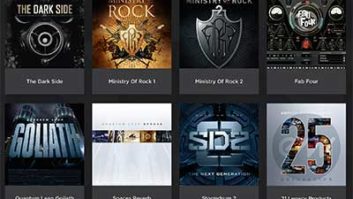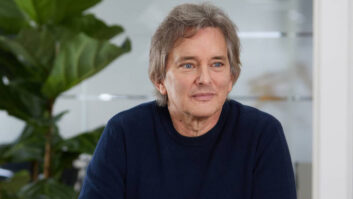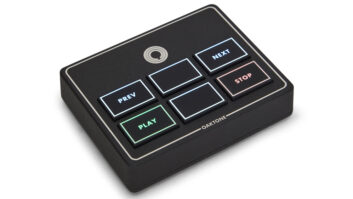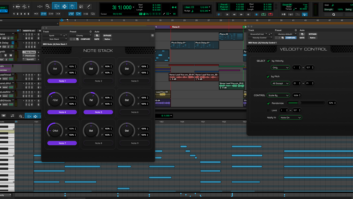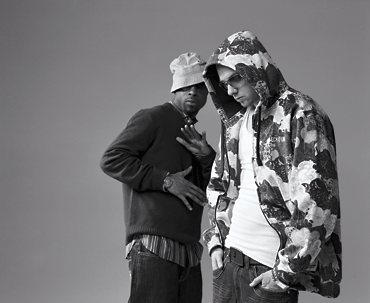

For the average producer, landing a career-making hit can take years of trial and error, mid-level chart positions and what feels like a lifetime of sessions. But the production/engineering/songwriting team of DJ Dirty Swift and Bruce Waynne, better known as Midi Mafia, is anything but average, and the wait for that hit lasted all of six months. Swift and Waynne were recruited to produce and mix 50 Cent’s “21 Questions,” a chart-topping sensation that immediately placed the duo in a whirlwind of attention and activity.
By the time they met, working in the same studio and cutting tracks for Bad Seed, Swift and Waynne had years of experience on their resumes. A professional relationship soon became a friendship, and they spent two years working for Sony Studios in what they describe as a “basement writers’ room.” With nonstop A-list artists coming in to track in the main rooms, it was an opportunity to network and bring beats to some of rap and hip hop’s biggest names. But the multifaceted duo never limited themselves to one genre, and as their name recognition increased so did demands for their talents, with artists such as Jennifer Lopez and Fantasia seeking them out; that’s their work on Fantasia’s Number One single, “When I See You.”
Bruce Waynne (left) and DJ Dirty Swift—aka, Midi Mafia—keep it real in the studio.
Together as Midi Mafia since 2003, Swift and Waynne have worked on singles, remixes, compilations and videogames. They have launched an imprint label, Family Ties, that enables them to sign and develop their own roster of talent, including urban pop singer Shire. This year, they’re again working with Fantasia, as well as UK artist Bryn Christopher, Earl Hayes, G-Malone, Lamar and many others. The Midi Mafia phones, it seems, never stop ringing.
Despite being on the cutting edge of technology, Swift and Waynne insist that theirs is an “old-school” approach: as hands-on as possible, involved in every step of the record-making process, and focused solely on the artist’s vision.
Looking back on your earliest projects, how have you grown and perfected your craft?
Waynne: When we got together, we were a couple of guys who needed each other to get to the next level of our careers. Our sound was all over the place; now it’s all over the place strategically. We keep everything melodic and soulful in feel, but young, fresh and urgent at the same time. Our music has matured from rap and hip hop. The hooks have changed into songs. We’re better producers, better at how we write and put things together. We’re more conscious of what we’re doing.
Swift: The method has always been the same. With pop artists, we bring in different types of instruments that we don’t need in rap. But we’ve always liked to be there from beginning to end. I mix, Bruce writes, we do arrangements. With rappers, we may need choruses. They write their own stuff and sometimes we send them beats, and when they send back the song it’s done. Some people you have to walk through the whole process.
How does the team work? How do your similarities and differences balance each other out?
Waynne: One of us starts the song. We make separate tracks. I’ll pick a beat he made and turn it into an R&B or pop song, and he takes something I made and turns it into something else. Our similarity is that we aim for hit records. We’re building a serious brand. A lot of artists today have an in-house producer and team, so if they come to us it’s because they want us to take them to another level. Our differences: He grew up in Canada listening to West Coast stuff; I’m from Brooklyn and I lived the music. My family is Jamaican, so in my house we listened to reggae. Everyone on the block was of a different ethnicity, so whatever Brooklyn was doing I was into it hard. Swift and I broke into the two sides of hip hop and we’re constantly learning from each other. Our different perspectives of hip hop come together. Hip hop is pop now; it’s edgy and street. What happened between Swift and me happened organically and naturally; we weren’t looking for it.
Swift: I help keep him focused. If it were up to him, we’d never finish a project. If it were up to me, we’d never start. We both make tracks, we both write. I do a lot of mixing. We focus on our strengths: I’m good at picking things out and arranging; he’s good at songwriting; and we both pick up the trash at the end of the day. Our personalities mesh. I never wanted to partner up with somebody, but when we met it worked. Together, we doubled our productivity. Over the years, we’ve become best friends and have mutual respect for each other. Plus, we can take the stress off of each other. If one of us is having a bad day, the other can handle things.
Did you have any idea that “21 Questions” would take off the way it did?,/b>
Swift: The nice thing is that we’d both been in the business a few years, had contacts and knew people in the game. It connected a lot of dots for us, but no one ever asked for another “21 Questions.” That song got so big, I’d hear it in cars all day driving down the road and not realize it was our song. It was the song. I was riding the subway on the D train and I’d hear it on people’s headphones. We knew we had to run with it. We did the label deal, began producing and we were prepared so that we wouldn’t be one-hit wonders — otherwise, we’d lose it. We had to make it work. There was no choice.
Technology allows you to collaborate with artists in different cities and countries. Isn’t making records that way somewhat impersonal?
Waynne: It allows us to do 10 things at once and maximize our time. Sometimes not having the artist in the room eliminates the B.S. We send out the track, they hear it, like it and that’s it. We’re very professional. We have a team of writers and musicians, and with technology we can narrow down what we like and be very honest and genuine. Sometimes when you’re in someone’s face, you’re afraid to hurt their feelings if you don’t like something or maybe the energy isn’t good at your first meeting. If you’re not together, there’s a mystique. You have a song, a better sense of the artist and a stronger working relationship as you direct the flow of the music. We take elements of each other, the artists and ourselves. Electronically, you can do things across the world at lightning speed, and that’s what Midi Mafia is about.
Swift: It can be impersonal, but if it’s an A-list rapper and he’s on tour, he can cut the record and all you have to do is mix. Others have to fly out and their schedules are crazy. If Bruce is in the UK, he can send files, I work on them and send them back without ever meeting the artist. It can be more efficient. It’s give and take. It’s better to be in the studio, but that can’t happen all the time. As much as possible, we try to get them to come to us. We just built a facility, Ravenite Studio, in Hollywood. I like to mix in my room, but we do what we have to. It depends on the artist. It’s nice to travel sometimes for a different vibe, but in L.A. I’ve got all my guys if I need a guitar player or choir.
How does the process work?
Swift: Basically, we set up an FTP server where we can upload, somebody else logs on, downloads and we work on tracks that way. It’s the most cost-effective way. We set up different servers for different artists and projects, and with Pro Tools it’s just computer files. Bruce can cut vocals in the UK and upload them, and I can mix. It’s not complicated. It’s like e-mail, but the files are too big, so on a server you can grab it.
Let’s talk about your studio and your gear.
Waynne: We’ve got the new Structure [sampler workstation] by Digidesign because Swift mixes in Pro Tools and we use so many tracks, vocals and musicians that it’s stable and not breaking down, so why go to a whole new system? Structure has a sample tank. We have an [Akai] MPC4000 that we’re not hanging up. We’re very, very heavy with virtual instruments: Spectrasonics’ Trilogy, Atmosphere, a lot of soft synths. We embellish samples with strong instrumentation. We can’t make music without soft synths. We have a custom system a friend helped us put together. Our on-hand musicians are all aspiring producers and understand each other’s thought processes. We also need guys who can write music. We’re really mixing a lot of variables.
The studio has four rooms. The main room is Swift’s, and I run between the other three rooms working with writers, beats and trying to keep Swift stable! He’s stronger when he’s making music and mixing. He can be objective in his opinions. When he mixes, I let him do what he’s doing and I don’t listen until it’s done. We give each other 100-percent freedom.
Swift: We change what we use all the time. I do beat programs directly into Pro Tools, and with Elastic Audio we can do everything in the box. I can do all my mixing directly into Pro Tools. We use Sony Oxford plug-ins, a Duende SSL and Waves SSL. They give me the feel of the analog SSL I started out on. I can work on five things at the same time, and at the pace we work it’s hard because we may get something from the UK [in] one night and they need it right away. We used to have to reset the boards; now, we just recall it in five minutes.
We have the MPC4000 and a rack of modules, but I use a lot of software plug-ins because they’ve gotten really good and flexible, and it’s easy to have everything in one place. Pro Tools and the SSL stuff are important for me because I mix as I go, and hearing it already mixed is important. The MPCs are still important to us. The most important thing to me is having optimal sounds, drums and effects on my hard drive so I can grab what I need. How I get to it doesn’t matter, whether it’s Pro Tools or the MPCs. The computer stuff is always evolving and I look every six months to see what’s new and think about it.
As far as mics, we’re open. I use a Sony C800 and a [Neumann] U87 a lot, which a lot of people think is overrated, but it’s my go-to mic — I know I won’t get a bad sound. I have a couple of [AKG] 414s for acoustic guitars, an Avalon M5 preamp — which is really neutral and clean — and I run everything through an LA-2A compressor for the tube circuitry to warm up the vocals, like Shire, who has a lot of power and midrange in her voice. I don’t use much outboard gear. I just keep it clean, put it into Pro Tools with no distortion and mix from there.
What is your definition of a producer?
Waynne: My job is to give the artists what they need to go to the next level. With a lot of producers, people come to them for their sound and it’s like a cookie-cutter and a tug-of-war for control. Our job is to be there, and say, “This is what you do and what you want to do; now, how do we get you there?” We try to keep it as simple as possible. The blueprint that works is to be very melodic, have words that connect to the artist and make them part of the process. The goal is to have more records, create a sound and guide the album.
Swift: The term “producer” is used loosely lately with people dropping off files. I take the old-school approach. It’s someone responsible for making sure the song happens from beginning to end, choosing where to record, who should be involved, do we need this or that, who is best to mix. I like to mix our stuff because I hear it a certain way in my head. It’s someone who keeps an eye on the budget, makes sure the artist is comfortable. In hip hop, the artist makes the tracks. They come in with a vision and we want to see it through, collaborate and, if needed, create the best material for that artist. You adjust accordingly, and [in the] best case you’re there to make sure the project starts and comes out right. There’s nothing worse than starting out with a song and someone screws it up in the mix because he doesn’t know your vision.
What is the Midi Mafia sound?
Waynne: I think our sound is melodic, and we make it in so many genres. I don’t believe in regurgitating things. If you hear J-Lo and Midi Mafia, Fantasia and Midi Mafia, and 50 Cent and Midi Mafia and put them all next to each other, they’re all different but all very melodic.
Swift: I always talk to Bruce about it because we don’t use the same musicians, instruments or sound. Our sound is not having a sound, in a way. Maybe there’s something to it because people say they know it’s a Midi Mafia beat. Everything we do is musical. I don’t know how people pick it out, but there is a common thread in what we’re building — the writing, the beats, some of the drum sounds. It’s production from the old-school approach: Mixing, writing, tracking and all that gives it a sound that will continue to grow. We work with so many people, and the next hit could be pop, then rap and all over the place. People hire us to do what we do and expect the Midi Mafia stamp, but we respect what the artists do. It’s their vision. We approach it from their perspective and what they need.
When is it time to walk away, or say, “It’s done”?
Waynne: You’re never done until it comes out. You’d be there forever. You always find different things and when it comes out, you say, “We should have done that.” We’re both perfectionists. When the label says, “We need that tomorrow, guys,” then it’s done!
Swift: Sometimes that’s the hardest thing for me because I’m such a perfectionist. If I had all the time in the world, I would go through the process and listen over and over and fix what bothers me until nothing bothers me. With Pro Tools I can walk away, recall it and hear something different. It’s a matter of interpretation. Sometimes people get married to the demos they record on a 2-track and — oh, man — the demo sounds like crap, but they like the feel and you have to figure out what they mean and duplicate it. Fantasia’s demo mixes were so good that we didn’t do anything but clean them up.
When you mix in the box, you mix as you go. The artist sings and the rough is 90 percent of the final mix. But if you record on 2-track, you’ve got to figure out how to get the raw feel and not overpolish. I pull up the demo when I’m mixing so that I can flip back and forth and preserve the elements they’re attached to. With Fantasia, she cut it, Clive Davis loved it, so that’s the final word. You don’t change it. She’s definitely a one-take vocalist. You get more for more options, but there’s never a bad take with her.
Do some artists and producers rely too much on technology?
Waynne: Yeah, some people sit there and take a vocal and it’s bulls*** because at the end of the day if the artist can’t sing, the artist can’t sing. Some are about the vibe and swagger, and technology can take all of that out.
Swift: Technology puts it in the hands of so many people that a lot of originality gets lost, but it exposes more people who might not be able to get into a studio and be creative. At the same time, it floods the marketplace with mediocrity. The cream rises to the top, but there’s more to wade through. We avoid it by always finding something new and never relying on one piece; we’re truly never stuck on one machine. I just find ways to make my life easier and work faster. I’m not married to anything, so going from ADAT to Pro Tools was an easy shift and going to soft synths from a rackmount was easy. You embrace what works for you and that’s it.
Elianne Halbersberg is a freelance writer.

LISTEN: Must Play
Shire’s “Miss My Love”
LISTEN: Must Play
Pprecious Paris’ “That’s What I’m About”
LISTEN: Must Play
Midi Mafia’s Ooohh Drama
